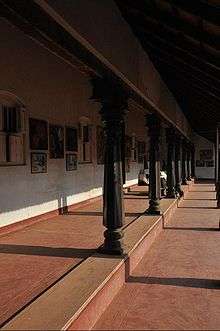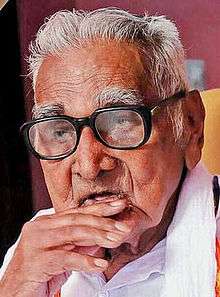Bunt (community)
| Total population | |
|---|---|
| (1,500,000 approx.) | |
| Religion | |
| Hinduism | |
| Related ethnic groups | |
| Jain Bunt |
Bunt (/ˈbʌnt/, previously spelled Bant and also known as Nadava[1]) is a community from Karnataka, India. They are traditionally found in the coastal and Kodagu[2] districts of Karnataka.[3] The Bunts are described as being the landed gentry and military class of coastal Karnataka.[4] Bunts traditionally follow the Hindu religion.[2] They are noted for following a matrilineal system of inheritance called Aliya Santana.[2]
Etymology
The word Bunt means powerful man or warrior in the Tulu language.[4]
The word Nadava is a synonym for the Bunts used in the northern region of the erstwhile South Canara district.[5] Krishna Iyer mentions that the Canarese (Kannada) speaking Bunts are called Nadava or Nad Bunts.[2]

History
According to S. D. L. Alagodi, the Bunts "originally belonged to the warrior class. Being the martial race of Tulu Nadu, they served the ruling chiefs which brought them considerable benefits and allowed them to become the landowners and nobles of the region."[4][6]
The Bunts are of Brahmin and Kshatriya descent from the Nagavanshi lineage and are forward caste.[7]
The feudal life and society of Bunts began to disintegrate in the succeeding colonial British Raj period. Bunts today are a largely urbanized community.[8]
Subdivision
There are about 90 clans found among the Bunts. They claim descent from the Alupas kings.[9][10]
Traditional houses


Traditional Bunt houses can be seen across the Tulu Nadu region. One of the more well-preserved houses, Kodial Guthu, stands at the centre of Mangalore city.[13][14] Other examples can be seen at Badila Guthu[15] in Kannur, Dakshina Kannada, Kowdoor Nayarbettu in Karkala taluk and Shirva Nadibettu near Udupi.[16]
Organisation
There are many organisations that cater to the needs of the community. These include the Bunts Mathr Sangha based in Mangalore.[17][18] Since the 20th century when Bunts began to emigrate out of their native region organisations have been formed elsewhere, such as in Mumbai,[19] Kuwait,[20] United Arab Emirates[21] and the United Kingdom.
See also
| Wikimedia Commons has media related to Bunt community. |
References
- ↑ Kāmat, Sūryanātha (1973). Karnataka State Gazetteer: South Kanara. Director of Print, Stationery and Publications at the Government Press. p. 108. Retrieved 14 May 2015.
- 1 2 3 4 Iyer, L. A. Krishna (1969). The Coorg tribes and castes (reprint ed.). Gordon Press Madras and Johnson. pp. 67–70. Retrieved 14 May 2015.
- ↑ International Journal of Dravidian Linguistics, Volume 14. Department of Linguistics, University of Kerala. 1985. p. 92. Retrieved 14 May 2015.
- 1 2 3 Alagodi, S. D. L. (2006). "The Basel Mission in Mangalore: Historical and Social Context". In Wendt, Reinhard. An Indian to the Indians?: on the initial failure and the posthumous success of the missionary Ferdinand Kittel (1832–1903). Studien zur aussereuropäischen Christentumsgeschichte. 9. Otto Harrassowitz Verlag. p. 143. ISBN 978-3-447-05161-3. Retrieved 2011-12-29.
- ↑ J. Sreenath, S. H. Ahmad (1989). All India anthropometric survey: analysis of data. South Zone. Anthropological Survey of India. p. 41. ISBN 9788185579054. Retrieved 14 May 2015.
- ↑ Hegde, Krishna (1990). Feudatories of Coastal Karnataka. Bharatiya Vidya Bhavan. p. 10.
Coastal Karnataka was home to number of feudatory rulers. All of them being Bunts following matrilineal inheritance called Aliya Santana and favouring both the Hindu and Jain Faith
- ↑ Dr. Neria H. Hebbar (30 January 2005). "The Bunts of Tulu Nadu". Retrieved 12 October 2016.
- ↑ Raghuram, M. "Bunts feel at home wherever they are". Daily News and Analysis.
- ↑ P.Gururaj BhatAntiquities of South Kanara (1969), Prabhakara Press, 1969
- ↑ P.Gururaj Bhat Studies in Tuluva history and culture: From the pre-historic times upto [sic] the modern (1975)
- ↑ Kamila, Raviprasad (2015-08-09). "Poet, freedom fighter Kayyara Kinhanna Rai no more". The Hindu. ISSN 0971-751X. Retrieved 2016-11-01.
- ↑ "'ಗಡಿನಾಡಿನ ಕಿಡಿ' ಕಯ್ಯಾರರಿಗೆ 90". kannada.oneindia.com. Retrieved 2016-11-01.
- ↑ Monteiro, John. "Mangalore: Kodial Guthu House Restored to Glory". Daijiworld Media. Retrieved 14 May 2015.
- ↑ Monteiro, John. "Mangalore: Once a Place of Pride, Kodialguttu now under Siege". Daijiworld Media. Retrieved 14 May 2015.
- ↑ Team Mangalorean. "Badila Guthu House - a Century old Heritage". Mangalorean.com. Retrieved 14 May 2015.
- ↑ Siraj, M. A. (3 March 2012). "You can go back in time here". The Hindu. Retrieved 14 May 2015.
- ↑ Daijiworld Media Network- Mangalore (RS/SP). "Mangalore: Bunts Sangh Felicitates Achievers from Various Fields". Daijiworld Media. Retrieved 14 May 2015.
- ↑ Daijiworld Media Network – Mangalore. "M'lore: Prof B M Hegde Exhorts Bunt Elders to "Walk their Talk"". Daijiworld Media. Retrieved 14 May 2015.
- ↑ "Bunts Sangha Mumbai". Bunts Sangha Mumbai. Retrieved 2013-05-25.
- ↑ "Welcome to Buntara Sangha Kuwait (BSK)". Kuwaitbunts.org. Retrieved 2014-06-08.
- ↑ "UAE Bunts 41st Annual Get Together 2015 | U.A.E Bunts". Retrieved 25 June 2016.
Further reading
- Rao, Surendra (2010). Bunts in History and Culture. Rastrakavi Govind Pai Research Institute. ISBN 9788186668603.